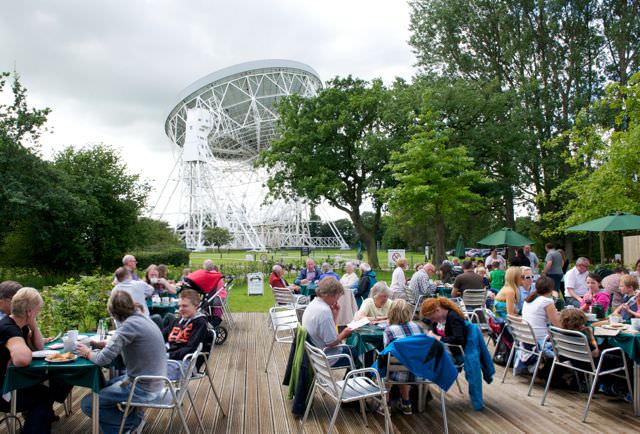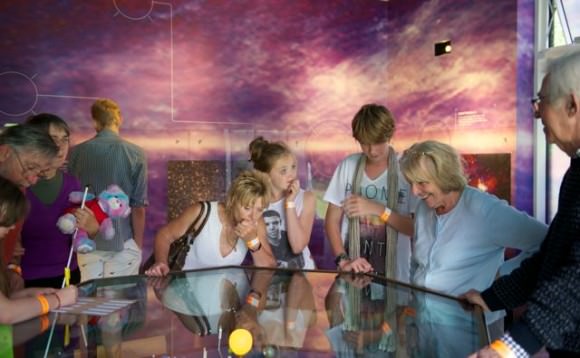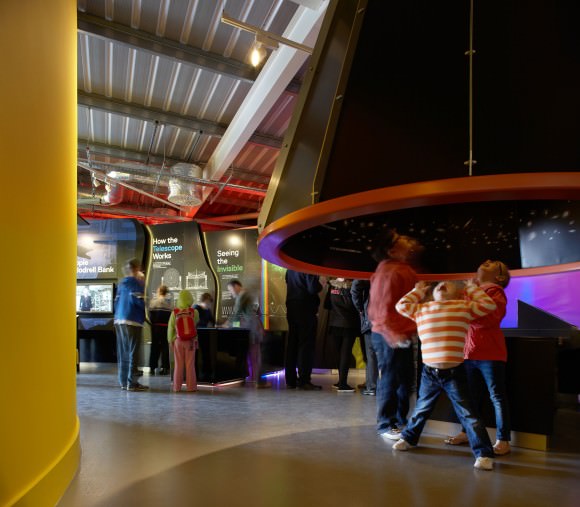Caption: The Lovell Telescope from The Discovery Centre Cafe. Credit: Howard Barlow for the University of Manchester
Ever get the feeling you are being watched? Visit Jodrell Bank in Cheshire, England and that feeling is doubled and intensified by two inescapable presences. First there is the vast 76 meter Lovell Telescope that dominates the site and the second is the spirit of the man who built it.
Sir Bernard Lovell came to Jodrell Bank in 1945, looking for a place away from the city, where the trams were interfering with the research he was carrying out into cosmic rays at the University of Manchester and it was here that he built his observatory. From the beginning he wanted to engage people with the work he was doing and the telescope he was building, that locals called “Lovell’s Contraption”. That dedication to public engagement and education continues to this day.
The new Jodrell Bank Discovery Centre opened in April 2011 and is watched over by the Director, Dr Teresa Anderson who studied for her physics degree at Manchester, took her PhD at the University of Edinburgh before returning to Jodrell to develop and build the new Centre. She is a woman who can stretch a budget till it squeals. She has managed to take the modest funds allocated to her and create an innovative, imaginative experience for visitors. Teresa is rightly proud of the site’s accessibility as well as its policy of using green energy.
She also has a wonderful eye for detail. The entrance to the Planet Pavilion is decorated with an embossed depiction of the 408 Mhz (radio continuum) map of the Milky Way. This building houses the gift shop and an inviting Cafe based on the theme of time. An array of different clocks on the wall show the passage of time on Earth, Venus (retrograde) Mars, Jupiter and a black hole. On the opposite wall is a timeline showing how far into the past we travel when viewing objects from Earth, one and a half seconds back in time when looking at the Moon, 8 minutes to the Sun and on back to the Big Bang. The glass doors give a stunning view of the Lovell telescope and open onto an outdoor dining area.
The reception area houses a display about the Lovell telescope and here staff post the latest astronomy related news bulletins, there is also a receiver that used to be installed on the Lovell which is currently on loan to the Centre. The cryogenic system used in receiver has to be cooled down to minus 260 degrees Celsius to reduce thermal noise from the receiver itself and engineers have just 20 minutes to get it up to the focus tower at the top of the dish and installed before is heats up.
Caption: Visitors at the Planet Pavilion. Credit: Howard Barlow for the University of Manchester.
A starlit passage echoing with the voices of Sir Bernard Lovell and Neil Armstrong leads you to a room where an early image of the CMB from the Planck mission is colourfully displayed around the walls (Jodrell constructed some low noise amplifiers for the mission) with a collection of touchscreen information points below that allow visitors to take part in quizzes and learn more. A beautiful clockwork orrery in the centre of the room has the IAU constellation maps including the 13 zodiac constellations (including Ophiuchus) which Teresa says, with a wry smile, causes some controversy with people who believe in astrology.
Outside is dominated by the Lovell Telescope. All the pathways are wheelchair and pushchair friendly and information boards are dotted along the circular pathway surrounding the dish giving information about the site, the telescope and the work it does. An acrylic sculpture of the Sun at the foot of the Lovell marks the centre of the Spaced Out project, the world’s largest scale model of the Solar System that stretches across the UK from Cornwall to the Shetland Isles.
The Space Pavilion’s glass front is adorned with Pulsar trace and is home to a wonderful hands-on science centre where you can print out a souvenir trace of what the Lovell is observing live or listen to the sound of the Big Bang, or touch a meteorite. There is a nice interactive touchscreen that introduces you to some of the people who work at the site and lets you ask them questions, an exhibit that explores the invisible universe of the different wavelengths of the electromagnetic spectrum and a film pod that runs science animations as well as archive film of Jodrell’s history. The building is also the heart of the year round education programmes that offer children of all ages, a unique learning experience and opportunity to experiment with live science. There is a flexible space that can be used as a lecture hall or host events and is home to the popular Ask a Scientist sessions and where an inflatable planetarium can be erected for visiting groups.
Caption: Space Pavilion at The Discovery Centre. Credit: Howard Barlow for the University of Manchester.
Outside again there are 35 acres of gardens to explore, including the newly opened Galaxy Garden designed by TV gardener Chris Beardshaw with willow spirals, island flowerbeds planted to illustrate astronomical themes such as light or star formation, a meadow with over 70 species of native wildflowers and a chalk depiction of our spiral galaxy craved into a hillside. The arboretum was created by Sir Bernard Lovell, also an internationally renowned arboriculturist, and contains 2,000 species of trees and shrubs.
There is a planet path and children can borrow backpacks that contain a map, instructions and activities they can try at each planet on the way. One of the outdoor exhibits always popular and crawling with children are the Whispering Dishes that have been kept from the original centre. This reusing of resources is very much a tradition at Jodrell, The motors used to move the Lovell scope were taken from two battleships HMS Revenge and Royal Sovereign, and a supermarket till receipt dispenser is now used to print out the live trace from the telescope.
Teresa is very keen to encourage more people to enjoy astronomy, and they host spectacular rock concerts featuring bands such as Flaming Lips and Elbow, against the backdrop of the Lovell scope with a surrounding science fair. Jodrell is also the home to the very popular, annual Stargazing Live series for BBC TV, three nights of live astronomy programmes hosted by Prof. Brian Cox and Dara O’Briain. The Centre is always keen to encourage more girls and women to become involved in physics and astronomy. Currently Teresa is overseeing The Girls Night Out (under the stars) on Sat 27th October 2012 being planned by her team, with talks by female astrophysicists, a chance to see Moon rocks under a microscope and they can also enjoy cocktails and cupcakes alongside the telescopes.
Over tea outside the Cafe, Teresa talked fondly of Sir Bernard and his vision and close involvement and support both of the Centre, and of Teresa herself. He will be sadly missed by everyone at Jodrell. She is justly proud that she was the principal author of the proposal that led to the Department of Culture Media and Sport including Jodrell Bank on the UK’s list for World Heritage Site Status. She gets a very determined look in her eye that I’m sure the funding committee knows well, when she talks of her many plans for future displays, projects and exhibits. I think Sir Bernard’s legacy is in safe hands.
(Part 2 of Jodrell Odyssey will go behind the scenes in a full, privileged access tour of this cutting-edge science facility)
Find out more about the Discovery Centre here




I visited the centre a few months ago – a fantastic place for anyone interested in the big scientific questions of our time. Good also to get close to the telescope whilst it’s in motion.
Every school-child should get to visit a place like this, to spark their imagination and inspire the next generation of scientists.
BTW: Small error in the text… light from the moon takes <1.5 Seconds to reach us, rather than the 1.5 minutes implied by the article.
Quite right Jon. That was (ahem) a deliberate error just to see if you were paying attention. Well spotted! ; )
Want to go to the discovery center? Follow @universetoday on Twitter
Read more: http://www.universetoday.com/97222/a-jodrell-odyssey-part-1-the-discovery-centre/#ixzz25iAoCZsU
“Lovell’s Contraption” ? – funny but I’ve lived with Jodrell Bank all my
life, in fact they finished it the year I was born and I have always
lived within sight of it and my grandad used to tend the gardens their
so I’ve always called it what everybody in the Chelford, Goostrey,
Holmes Chapel, Alderley Edge areas called it and everybody knew what
you meant by ‘Bernie’s Basin’
“The huge yellow somethings
went unnoticed at Goonhilly, they passed over Cape Canaveral without a blip,
Woomera and Jodrell Bank looked straight through them – which was a pity because
it was exactly the sort of thing they’d been looking for all these years.”
I want to visit it! 🙂